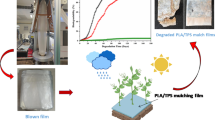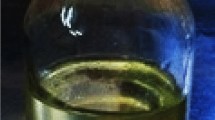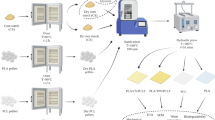Abstract
The preparation of biodegradable films using, tamarind seed powder (TSP) and fenugreek seed powder (FSP) has been reported herein. The tamarind seed powder (TSP) was used to prepare pure films as T1, T2 and T3, based on particle size Grade-I, II and III, similarly, FSP films were prepared as F1, F2 and F3, whereas composite films from (TSP and FSP) were prepared with (50:50) ratio based on above grades were as TF1, TF2 and TF3, respectively. The textural properties of the films prepared from pure TSP as T1; pure (FSP) as F1 and composite films of TSP and FSP as TF1 were found to be better than that of other films. The heat capacity (Hc), determined using DSC, was found in the range of 0.089–2.260 kgm2/ks2 for all the films. The microbial analysis performed using the Aerobic colony count and Yeast and mold count methods showed the least microbial count for the film containing FSP due to the anti-microbial properties of fenugreek. The SEM analysis found smoother surfaces with the closeness of pores for T1, F1 and TF1 films. The Water vapor permeability was in the range of 0.49–0.82 mg/Pa.s.m2 × 10–11. The evaluation of the biodegradability of the films was done by soil burial test, and intrinsic viscosity measurements at different time intervals were found better results for T1, F1 and TF1 films. Pure TSP and pure FSP films with Grade I mucilage found better for packaging application.



Similar content being viewed by others
References
Ncube LK, Ude AU, Ogunmuyiwa EN, Zulkifli RB, Isaac N (2020) Environmental impact of food packaging materials: a review of contemporary development from conventional plastics to polylactic acid-based materials. Materials 13(21):4994. https://doi.org/10.3390/ma13214994
Dwivedi P, Mishra PK, Mondal MK, Srivastava N (2019) Non-biodegradable polymeric waste pyrolysis for energy recovery. Heliyon 5(8):e02198
Gouveia TIA, Biernacki K, Castro MCR, Gonçalves MP, Souza HKS (2019) A new approach to develop biodegradable films based on thermoplastic pectin. Food Hydrocoll 97:105–175
Wu C, Li Y, Sun J, Lu Y, Tong C, Wang L, Yan Z, Pang J (2020) Novel konjac glucomannan films with oxidized chitin nanocrystals immobilized red cabbage anthocyanins for intelligent food packaging. Food Hydrocoll 98:105245
Tran TTB, Roach P, Minh HN, Pristijono P, Vuong QV (2020) Development of biodegradable films based on seaweed polysaccharides and Gac pulp (Momordica cochinchinensis), the waste generated from Gac oil production. Food Hydrocoll 99:105322
Basch C, Jagus R, Flores S (2013) Physical and antimicrobial properties of tapioca starch-HPMC edible films incorporated with nisin and/or potassium sorbate. Food Bioprocess Tech 6(9):2419–2428
Real AD, Wallander D, Maciel A, Cedillo G (2015) Graft copolymerization of ethyl acrylate onto tamarind kernel powder, and evaluation of its biodegradability. Carbohydr Polym 117:11–18
Mishra A, Malhotra AV (2009) Tamarind xyloglucan: a polysaccharide with versatile application potential. J Mater Chem 19(45):8528–8536
Kaur M, Singh S (2016) Physicochemical, morphological, pasting, and rheological properties of tamarind (Tamarindus indica L.) kernel starch. Inter J Food pro 19:2432–2442
Picone P, Sabatino MA, Ajovalasit A, Giacomazza D, Dispenza C, Carlo MD (2019) Biocompatibility, hemocompatibility and antimicrobial properties of xyloglucan-based hydrogel film for wound healing application. Int J Bio Macro 121:784–795
Barnwal P, Singh KK, Mohite AM, Sharma A, Saxena SN (2015) Influence of cryogenic and ambient grinding on grinding characteristics of fenugreek powder: a comparative study. J Food Process Preserv 39:1243–1250
Hefnawy HTM, Ramadan MF (2011) Physicochemical characteristics of soy protein isolate and fenugreek gum dispersed systems. J Food Sci Technol 48:371–377
Geberemeskel GA, Debebe YG, Nguse NA (2019) Antidiabetic effect of fenugreek seed powder solution (Trigonella foenum-graecum L.) on hyperlipidemia in diabetic patients. J Diabet Res 2019:8507453. https://doi.org/10.1155/2019/8507453
Singh KK, Kumar P (2014) Selected physico-mechanical characteristics of cryogenic and ambient ground turmeric. Int Agrophys 28:111–117
AOAC (2000) Official methods of analysis, Association of Official Analytical Chemists. 17th edn. Inc., Arlington, Virginia
Mohite AM, Mishra A, Sharma N (2020) Effect of different grinding processes on powder characteristics of tamarind seeds. Agric Res 9(2):262–269. https://doi.org/10.1007/s40003-019-00431-9
Mohite AM, Sharma N, Aggarwal S, Sharma S (2018) Effect of tamarindus coating on post-harvest quality of apples and pears stored at different conditions. Carp J Food Sci Tech 10(3):17–25
ASTM (2001) Standard test method for tensile properties of thin plastic sheeting. In: Standard designations D882-01. Annual book of ASTM standards. American Science Testing and Materials, Philadelphia, PA
Sharma L, Singh C (2016) Sesame protein based edible films: development and characterization. Food Hydro 61:139–147
López-Mata MA, Ruiz-Cruz S, Silva-Beltrán NP, Ornelas-Paz JJ, Ocaño-Higuera VM, Rodríguez-Félix F, Cira-Chávez LA, Del-Toro-Sánchez CL, Shirai K (2015) Physicochemical and antioxidant properties of chitosan films incorporated with cinnamon oil. Int J Poly Sci 2015:974506. https://doi.org/10.1155/2015/974506
Ramani R, Alam S (2012) Influence of an organophosphonite antioxidant on the thermal behavior of PEEK/PEI blend. Thermochim Acta 33:550
ASHRAE Handbook (1997) Fundamentals; American society of heating and refrigerating and air conditioning engineers, Inc., New York
Mohite AM, Chandel D (2020) Formulation of edible films from fenugreek mucilage and taro starch. SN Appl Sci 2:1900. https://doi.org/10.1007/s42452-020-03710-1
Deepa B, Abraham E, Pothan LA, Cordeiro N, Faria M, Thomas S (2016) Biodegradable nanocomposite films based on sodium alginate and cellulose nanofibrils. Materials 9:50
Martucci JF, Ruseckaite RA (2009) Biodegradation of three-layer laminate films based on gelatin under indoor soil conditions. Polym Degrad Stab 94:1307–1313
Sharma L, Sharma HK, Saini CS (2017) Edible films developed from carboxylic acid cross-linked sesame protein isolate: barrier, mechanical, thermal, crystalline and morphological properties. J Food Sci Tech 55(2):532–539
De Moraes Crizel T, de Oliveira Rios T, Alves DV (2018) Biodegradable films based on gelatin and papaya peel microparticles with antioxidant properties. Food Bioprocess Technol 11:536
Senthil MK, Rajini N, Huafeng T, Varada RA, Winowlin Jappes JT, Suchart S (2017) Development and analysis of biodegradable poly(propylene carbonate)/tamarind nut powder composite films. Int J Polym Anal Charact 22(5):415–423
Oses J, Fabregat-vazquez M, Pedroza-Islas R, Tomas SA, Cruzorea A, Maté JI (2009) Development and characterization of composite edible films based on whey protein isolate and mesquite gum. J Food Eng 92(1):56–62
Gontard N, Guilbert S (1994) Bio-packaging: technology and properties of edible and/or biodegradable material of agricultural origin. In: Mathlouthi M (ed) Food packaging and preservation. Blackie Academic and Professional, Glasgow
Rawdkuen S, Suthiluk P, Kamhangwong D, Benjakul S (2012) Mechanical, physico-chemical, and antimicrobial properties of gelatin-based film incorporated with catechin-lysozyme. Chem Cent J 6(1):131
Masuelli MA (2018) Intrinsic viscosity determination of high molecular weight biopolymers by different plot methods chia gum case. J Poly Biopoly Physic Chemis 6(1):13–25
Patricia C, Gonzalo V, José A, Ramírez MV (2017) Polysaccharide-based films and coatings for food packaging: A review. Food Hydrocoll 68:136–148
Freitas F, Alves VD, Reis MA, Crespo JG, Coelhoso IM (2014) Microbial polysaccharide-based membranes: current and future applications. J Appl Polym Sci 131(6). https://doi.org/10.1002/app.40047
Author information
Authors and Affiliations
Corresponding author
Additional information
Publisher's Note
Springer Nature remains neutral with regard to jurisdictional claims in published maps and institutional affiliations.
Rights and permissions
About this article
Cite this article
Mishra, A., Mohite, A.M. & Sharma, N. Influence of particle size on physical, mechanical, thermal, and morphological properties of tamarind- fenugreek mucilage biodegradable films. Polym. Bull. 80, 3119–3133 (2023). https://doi.org/10.1007/s00289-022-04214-1
Received:
Revised:
Accepted:
Published:
Issue Date:
DOI: https://doi.org/10.1007/s00289-022-04214-1




